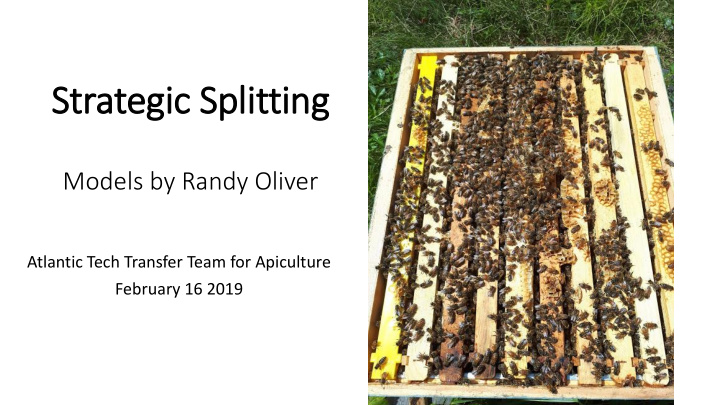



Strategic Splitting Models by Randy Oliver Atlantic Tech Transfer Team for Apiculture February 16 2019
What is splitting and why do we split? • Recover winter losses • Increase hive numbers • Prevent swarming • Make nucleus colonies for sale • Save $$$ • Splitting existing colonies to expand your apiary costs relatively little compared to buying bees in the form of packages, nucs, or full colonies.
Splitting in the Maritimes • Sometimes before blueberry pollination • Early – mid May • Pollination units • More commonly after pollination • End of June – July • Make sure your hive is strong enough to split • Generally 6-10 frames of brood in the parent colony • Alternatively, you can split your unproductive colonies after pollination • They won’t make you any honey anyway!
Randy Oliver’s Models • Model assumptions: • Results are theoretical based on projected growth under best possible conditions • 2000 bees covers 1 frame • 1 frame of brood = 65% coverage with brood of all ages • Not limited by nectar or pollen • All frames added are drawn comb • Most appropriate for post pollination splitting (end of June, early July) in our region
Don’t Overestimate Brood Frame Coverage!
Remember • There are numerus ways to split colonies • The models in this presentation only show a FEW of the many possible ways to split hives
• 2 pound package
• 5 frame nuc – laying queen • Reaches 20 frame strength after 42 days (24 days sooner than a package)
5 Frame Nuc – Laying Queen 2 pound package
• 5 frame nuc with ripe queen cell • Reaches 20 frame strength only 12 days later than with a laying queen, but you save $$ and control genetics
5 Frame Nuc – Laying Queen 5 Frame Nuc – Queen Cell
• 4 frame nuc with ripe queen cell • Reaches 20 frame strength only 3 days later than a 5 frame nuc
5 Frame Nuc – Queen Cell 4 Frame Nuc – Queen Cell
• 4 frame nuc with a ripe queen cell, 3 frames of brood • Reaches 20 frame strength 9 days earlier than a 4 frame nuc with 2 brood frames
4 Frame Nuc – Queen Cell 4 Frame Nuc – Queen Cell Extra Brood
• Walk away split • Reaches 20 frame strength 5-6 days later than a 5 frame nuc with a ripe queen cell, and 15-16 days later than a five frame nuc with a laying queen
5 Frame Nuc – Queen Cell Walkaway Split
What does this mean? • Adding a laying queen to a nuc gives you an extra 12 days of growth compared to a ripe queen cell • There is no major difference between a 4 and 5 frame nuc with 2 frames of brood • Adding an extra frame of brood in a nuc can boost production by 10 days • Walkaway splits are the least productive use of your resource • By adding ripe queen cells or a laying queen to a nuc, you can make two, 5 frame nucs with the same resource, and they will reach 20 frame strength 5- 15 days earlier than a walkaway split
Walkaway vs 5 frame with ripe queen cell Forget 20 frames, look at development time for 10 frames of bees, 12 frames of bees and so on…
Walkaway vs 5 frame with mated queen Forget 20 frames, look at development time for 10 frames of bees, 12 frames of bees and so on…
How does this translate to $$$ Classic Walkaway Strategic Splitting with cells and queens 20 20 frame frame double double 5 bees 5 bees 10 bees 10 bees 10 bees 2 brood 2 brood 4 brood 4 brood 4 brood queen queen No queen queen cell queen cell Here, we can make two splits with the same resource as one walkaway, and they actually develop faster and reach 20 frames of bees faster than a traditional walkaway
How does this translate to $$$ • Extra cost: Smarter Splitting with cells and queens • $ 10-20 if using queen cells • $ 50-80 if using mated queens. 20 frame double • But for the same allocation of resource, you gain one extra hive per split for: • Recovery from winter losses • One more hive for pollination 5 bees 5 bees 10 bees 2 brood 2 brood 4 brood queen queen ($ 130-160) cell queen cell • Additional honey production Here, we can make two extra splits with the same resource as (difficult to estimate $$) a walk away, and they actually develop faster and reach 20 frames of bees faster than a traditional walkaway
Questions? Sawyer Olmstead solmstead@perennia.ca Robyn McCallum rmccallum@perennia.ca
Recommend
More recommend